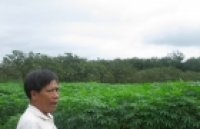| Genetic control of pod morphological traits and pod edibility in a common bean RIL population |
|
Bean pod phenotype is a complex characteristic defined by the combination of different traits that determine the potential use of a genotype as a snap bean. In this study, the TUM RIL population derived from a cross between ‘TU’ (dry) and ‘Musica’ (snap) was used to investigate the genetic control of pod phenotype. The character was dissected into pod morphological traits (PMTs) and edible pod characteristics (EPC). The results revealed 35 QTL for PMTs located on seven chromosomes, suggesting a strong QTL colocation on chromosomes Pv01 and Pv06. Some QTL were colocated with previously reported QTL, leading to the mapping of 15 consensus regions associated with bean PMTs. |
|
Carmen García-Fernández, Maria Jurado, Ana Campa, Elena Bitocchi, Roberto Papa & Juan Jose Ferreira Theoretical and Applied Genetics; January 2024; vol. 137; Article 6 Key messageQTL mapping, association analysis, and colocation study with previously reported QTL revealed three main regions controlling pod morphological traits and two loci for edible pod characteristics on the common bean chromosomes Pv01 and Pv06. AbstractBean pod phenotype is a complex characteristic defined by the combination of different traits that determine the potential use of a genotype as a snap bean. In this study, the TUM RIL population derived from a cross between ‘TU’ (dry) and ‘Musica’ (snap) was used to investigate the genetic control of pod phenotype. The character was dissected into pod morphological traits (PMTs) and edible pod characteristics (EPC). The results revealed 35 QTL for PMTs located on seven chromosomes, suggesting a strong QTL colocation on chromosomes Pv01 and Pv06. Some QTL were colocated with previously reported QTL, leading to the mapping of 15 consensus regions associated with bean PMTs. Analysis of EPC of cooked beans revealed that two major loci with epistatic effect, located on chromosomes Pv01 and Pv06, are involved in the genetic control of this trait. An association study using a subset of the Spanish Diversity Panel (snap vs. non-snap) detected 23 genomic regions, with three regions being mapped at a position similar to those of two loci identified in the TUM population. The results demonstrated the relevant roles of Pv01 and Pv06 in the modulation of bean pod phenotype. Gene ontology enrichment analysis revealed a significant overrepresentation of genes regulating the phenylpropanoid metabolic process and auxin response in regions associated with PMTs and EPC, respectively. Both biological functions converged in the lignin biosynthetic pathway, suggesting the key role of the pathway in the genetic control of bean pod phenotype.
See https://link.springer.com/article/10.1007/s00122-023-04516-6
Figure 2: Location of QTL associated with PMTs and genomic regions involved in the control of EPC (EDIBILITY) on the TUM linkage map. QTL are presented as vertical bars on the right of the chromosome. The regions associated with the edible-pod character are indicated as vertical bars of asterisk. The grey boxes indicate the regions with overlapping QTL for PMTs. |
|
|
|
[ Tin tức liên quan ]___________________________________________________
|


 Curently online :
Curently online :
 Total visitors :
Total visitors :
(227).png)


